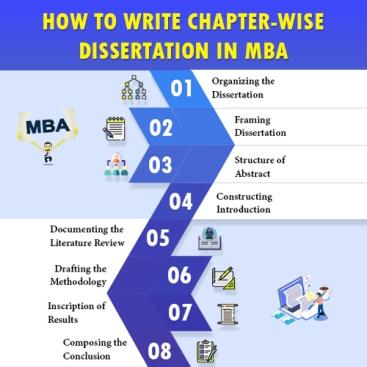How to Write Chapter-wise Dissertation in MBA
In Brief
- In general, MBA students seem to experience an abundance of equivalent challenges as implementing their MBA dissertations.
- One of the most crucial reasons that MBAs suffer to complete their dissertation is improper time planning. In an attempt to support these issues, we have drawn up this concise article.
- This blog provides complete dissertation writing services to help students with writing their part of the dissertation in the MBA.

Introduction
To experience a successful dissertation, the right first case is to understand the dissertation structure. The layers of basic dissertation structure are explained in this blog to help students with writing chapter-wise dissertation. Here, the conventional dissertation structure and its layout are commonly used across the US, UK, Europe or Australia universities. In contrast, few universities might have slight modifications to this dissertation structure, i.e., they expect the supplementary portion called the personal reflection chapter. They could choose to integrate the results and discussion part into a single chapter. However, the overall flow will be constant throughout the process since the flow indicates the research process.
Organizing the Dissertation
This section is unavoidable because working on a literature review, sketching appropriate research problems, data collection, comparison and evaluation usually takes a longer period than anticipated. Similarly, composing a dissertation might be a difficult thing. The collective need of this part is to figure out the proposal plan, include a pause when the chips are down, even so, especially be determined about fulfilling deadlines. The student’s responsibility is to make sure that achievements for the literature review and so forth are attained. Older drafts are widely endorsed as this helps you to get special comments on your work.
Framing Dissertation
Ultimately, for an MBA project, the way of writing will reflect the work or dissertation done by you. Things you’ve done so far and the effort you put in it are secondary when it comes to dissertation writing. The utmost important thing considered here is the technique of writing; hence proper attention is required. A finest unspoken rule is that your dissertation grade will indicate only 20% creativity and excellence of your content and 80% perseverance with respect to presentation and framing the work to ensure that the reader quickly understands the concept you are trying to disclose. The relatively conventional structure that is being followed comprises abstract, introduction, literature review and theoretical background, research hypotheses, methodology, results, discussion, recommendations, conclusions, references, appendices.
The subsequent observation provides a certain understanding into every content and implies the generation of links.

Find out: dissertation writing services near me
Structure of Abstract
The abstract of the dissertation should concentrate on attracting the reader. Hence, the summary of the abstract must not exceed a single page. It concisely explains the investigation undergone for the thesis and its importance and sketches the significant achievements. It is recommended to shorten the significant achievements for about 3-5 bullet points. Also, the abstract must be the very last section of writing prior to submission. Therefore, the reader could get the exact outline of the overall dissertation.
Constructing Introduction
The introduction part establishes the framework, structures the schedule and designs the important concerns. It comprehends description of the problem, theoretical or intellectual framework, observation of the objective, research questions, importance of the study and briefing of the terms used.
The problem description should highlight the reason for performing this study. It is not advisable to be excessively long but requires adequate length to explain its contribution to the concerned problems.
In the theoretical framework, the presentation should contain a short but considerable summary of the theory that encircles the study and concisely encapsulates formerly undertaken studies that are most appropriate to the topic under exploration.
The observation of the objective is a discrete, direct, concise part that particularly declares the use of the study. This section of the dissertation explains what the study is trying to invent or explore. It differentiates the study into parts of how and what the dissertation is conveying and provides a better understanding.
The research questions are raised at this current juncture. They are probably a condensed statement of the detailed consequences foreseen from the research. Hypotheses might be presumed subject to the research prototype governing the study.
The research must be appropriated pertaining to the determined theory, formerly undertaken research, and the importance of the professionals and experts’ expected results. Eventually, this is the comprehensive statement to brief the importance of the study.
The technical or scientific terms in the dissertation should be defined in the introduction part to ensure the reader understands them. Despite that, it generally does not consist of a broad explanation in the dissertation.
Documenting the Literature Review
This section acts as the base of the research and determines the results and findings of the study. It briefly explains what the study establishes and explores that are yet to be identified in the dissertation. The extent of the literature review is clearly based on the duration of the previous work. In a literature review, irrelevant statistics/information is not included, but important discoveries and appropriate methodological issues must be incorporated. Suitable examples of research that reviews the outcomes that are not sustaining the issue mentioned in the dissertation are also not included.
Drafting the Methodology
The methodology segment illustrates the reader with the method of the study that is planned to be conducted. The procedures followed in conducting the research that helps future researchers refer to the methodology to finalize the decision to reproduce the research. The research questions in the introduction part are duplicated in this methodology section preceding with the brief introduction.
The study pattern explains and specifies the area to be studied. Several patterns of study are available to the researcher. The specific pattern selected is defined in this section. Every step that is implemented in this research is explained thoroughly. The tools evaluating the variables and the data sources used in performing this research are mentioned in this part of the dissertation. The survey tools must illustrate the development of the survey and its specifications.
The data collected for performing the research and the examination of those gathered data, moral factors, speculations/hypotheses, limitations and identifications, and the timeline of this research are extensively demonstrated in this section.
Inscription of results
The authentic disclosure of this study is represented in the results section. Tables may be used to sum up the findings or data in the study. The elaborated information can be presented in the appendix. The overview of the investigation outcomes represented at the end of the results section or in the beginning of the conclusion, but not in both.
Composing the Conclusion
The suggestions of the undergone research are discussed in this part. The suggestions discussed may be useful for the practice or for the future research. Finally, the dissertation is completed with a convincing conclusion briefing the significance of research outcomes.
Conclusion
This master dissertation writing service anticipates providing the appropriate structure or layout of the dissertation. This blog enables MBA students to present a complete dissertation as expected by eliminating substantive inferences that are highly rigorous. It offers to deliver important manifestations at a certain level.
References
- Test, G. E., Mba, B. A., Honesty, E. O., Reward, B. B. R. A., Com, E. W., Ne, B. B. R. A. L., … & Letter, D. C. (2015). Uk Essays.
- Lomas, R. (2013). Mastering your Business Dissertation: How to conceive, research and write a good business dissertation. Routledge.

 Previous Post
Previous Post Next Post
Next Post